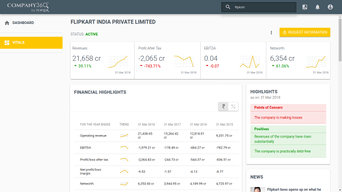Interest Coverage Ratio
What is Interest Coverage Ratio (ICR)?
Financial analysts use various measures in conducting solvency checks for any organization. They use certain ratios in deciphering the capability of a firm to pay off its interest accumulated on a debt. The interest coverage ratio is one of them.
The ICR is a financial ratio that is used for determining how good a company is at paying interest on its outstanding debts. It is commonly employed by creditors, lenders, and investors for determining the riskiness of lending capital to a company. This ratio is also referred to as the “times interest earned” ratio.
It has to be noted that this ratio does not take into consideration the repayment of the principal debt amount. It is all about the ability of a firm to settle interest accrued on the credit borrowed from an investor.
Key Insights:
- The interest coverage ratio determines the ability of a company to pay off its debts
- Creditors use this ratio to determine the financial health of a company
- The investors may find a lower ICR unattractive as it hints that the company is not poised for growth
- Performing trend analysis of ICR provides a clear picture of the stability of the company pertaining to its interest payments
How to calculate the Interest Coverage Ratio calculated?
The calculation of interest coverage ratio is done by dividing the earnings generated by a firm before expenditure on taxes and interest by its interest expenses within the same period. The ratio is used extensively by creditors, investors, and lenders to gauge the risk when it comes to lending money to companies seeking funds. In short, the interest coverage ratio helps in assessing the profitability of a company.
Here is the interest coverage ratio formula.
Interest Coverage Ratio = EBIT / Interest Expense
Where EBIT represents the company’s operating profit. Interest Expense indicates the applicable interest on its borrowings.
Interest coverage ratio example:
Let us take an example of a Company ABC Pvt. Ltd. which has reported total revenue of ₹10,0 00,000 with costs of goods sold of ₹500,000. The operating expenses reported were ₹520,000 in salaries, ₹1, 12,000 in rent, ₹200,000 in utilities, and ₹120,000 in depreciation. The interest expense for the period is ₹3,000,000.
The income statement of the company reported is shown in the table below.
| Sales Revenue | ₹10,000,000 |
| Cost of Goods Sold | ₹500,000 |
| Gross Profit | 9,500,000 |
| Total Expenses | |
| Salaries | ₹520,000 |
| Rent | ₹112,000 |
| Utilities | ₹200,000 |
| Depreciation | ₹120,000 |
| Operating Profit (EBIT) | ₹8,548,000 |
| Interest Expenses | ₹3,000,000 |
Interest Coverage Ratio = ₹8,548,000 / ₹3,000,000 = 2.84
In this example, the company has an interest coverage ratio of 2.84. A ratio between 2.5 and 3 indicates that the firm can pay off its accumulated interest on debt with its current earnings. However, it also serves as an indicator about the internal policies of the firm or its contractual requirement for maintaining a high interest coverage ratio.
No matter what the situation is, it has to be noted that what would generally be accepted as a good interest coverage ratio for some sectors or industries may not be potent enough for others. For instance, industries with sales such as natural gas and electricity among other essential utility services tend to have a low-interest coverage ratio.
On the other hand, industries that experience fluctuating sales such as manufacturing, technology, and others tend to have a higher IRC ratio. Subsequently, the good interest coverage ratio for such sectors will be different and may not be comparable with that of other domains. Nonetheless, it has to be noted that a high EBIT cannot be considered to be reliable proof of a high ICR.
Interpretation of Interest Coverage Ratio:
The lower the interest coverage ratio is, the greater are the debts owed by a company and greater is its possibility of going bankrupt. A lower ratio also indicates that the company has less operating profits available for meeting its interest payments. Also, it hints that the company is more susceptible to volatility in interest rates. A higher interest coverage ratio on the other hand indicates stronger financial health and also hints that the company is capable of meeting its interest obligations.
A high ratio may also indicate that the company is overlooking opportunities for magnifying its earnings through leverage. As per the rule of thumb, a ratio of ICR above 2 is barely accepted for companies that have consistent cash flows and revenues. In certain cases, analysts prefer having an ICR ratio above 3. A value lower than 1 indicates that the financial health of the company is poor and that it is incapable of paying off its short-term interest obligations.
Significance of Interest Coverage Ratio:
Performing a thorough analysis of the interest coverage ratio helps in getting a better idea of the firm’s stability. It also assists lenders in evaluating the creditworthiness of a company before extending the credit to the company.
The stakeholders such as investors and creditors employ this ratio for gauging the profitability of the firm and to take timely decisions. It is also a handy ratio in gauging the short-term financial health and financial stability of the company. Trend analysis of this ratio offers valuable insights into the stability of the company when it comes to repaying the interest.
In Summary:
For analyzing a firm’s financial statements, it is essential to use interest coverage ratio along with various metrics such as debt-to-equity ratio, cash ratio, current ratio, quick ratio, etc. It will also help in maximizing the benefits of the said metric and will enable in cushioning the shortcomings in a much better way for the creditors or investors.
Company360 plans

Know more about your vendors, clients and competitors.
Financials, scores, ratios, excels, reports and more.
@ INR 9000/quarter